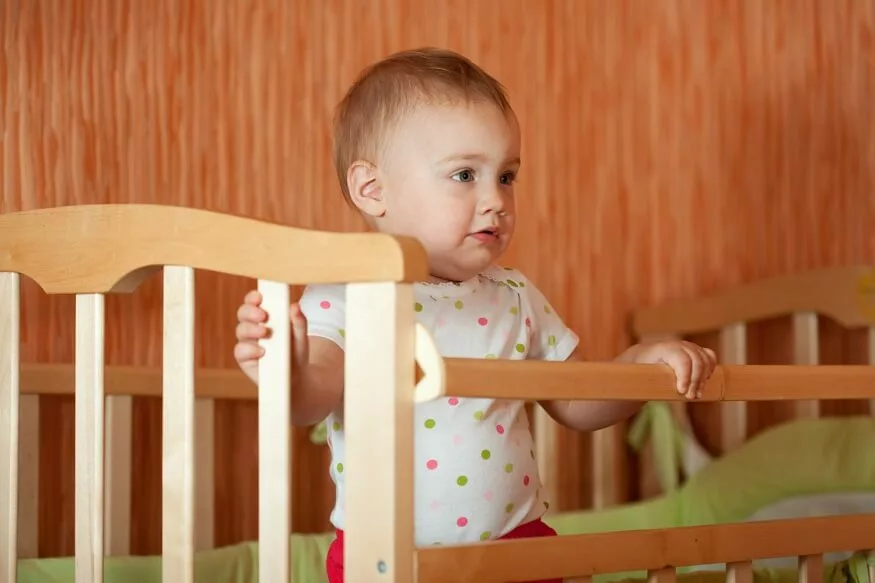One common concern for parents is the toddler’s newfound ability to scale the confines of their baby crib. The quest for the best cribs becomes crucial as toddlers evolve into aspiring mountaineers, exploring the heights of their cribs with surprising agility. This article delves into effective strategies and preventive measures to ensure that your little one stays safe and snug in their crib, even if they’re eager climbers.
Understanding the Urge to Climb
Toddlers are naturally curious beings, and as they develop both physically and cognitively, the desire to explore their surroundings intensifies. Climbing out of the crib is often a manifestation of this curiosity and the budding independence toddlers crave. Recognising and addressing this urge is the first step in implementing effective crib climbing prevention. Here are some tips that you can try to prevent toddlers from climbing out of their cribs
Investing in the Best Cribs
Choosing the right crib can significantly contribute to crib climbing prevention. Opting for a deep crib designed specifically for climbers is a wise decision. The best cribs for toddlers who are inclined to scale the walls are those with higher railings, making it more challenging for little adventurers to make their great escape. Consider cribs that meet safety standards while providing a secure environment for your child.
Also Read: Sleep Regression in Infants – Signs, Causes and What to Do
Adjusting Crib Height
Most cribs come with adjustable mattress heights. As your toddler grows and becomes more mobile, lowering the mattress to its lowest position can act as a deterrent against climbing. A lower mattress reduces the gap between the top of the railing and the mattress, making it more challenging for your little one to hoist themselves over.
Introducing Sleep Sacks
Sleep sacks, or wearable blankets, are not only a cosy addition to your child’s bedtime routine but can also serve as a practical solution for crib climbing prevention. By restricting the movement of your toddler’s legs, sleep sacks make it more difficult for them to lift their legs over the crib railing. Ensure that the sleepsack is the appropriate size for your child, promoting both safety and comfort.
Creating a Comfortable Sleep Environment
A conducive sleep environment plays a crucial role in preventing crib climbing. Ensure that the crib is void of any tempting objects that may encourage your toddler to climb out. Soft toys, crib bumpers, or any other items that can be used as leverage should be kept out of reach. A minimalist approach to the crib’s interior not only reduces climbing incentives but also fosters a safer sleep environment.
Promoting Daytime Physical Activity
A well-exercised toddler is less likely to engage in restless activities, such as attempting to climb out of their crib. Regular daytime physical activity not only contributes to a healthier lifestyle but also aids in better sleep patterns. Engage your toddler in age-appropriate physical activities, allowing them to expend their energy during waking hours.
Establishing a Consistent Bedtime Routine
Consistency is key when it comes to toddler behaviour. Establishing a predictable bedtime routine can create a sense of security and routine for your child. A consistent routine signals to your toddler that it’s time to wind down and prepares them for a restful night’s sleep, reducing the likelihood of crib climbing as a means of protest or restlessness.
Installing a Crib Tent
For parents seeking a more direct approach to crib climbing prevention, crib tents are a practical solution. These mesh covers are designed to fit securely over the crib, creating a barrier that discourages climbing attempts. Ensure that the crib tent is installed correctly, following the manufacturer’s instructions to guarantee both safety and efficacy.
Monitoring from Afar
Investing in a reliable baby monitor allows you to keep a watchful eye on your toddler without physically being in the room. Modern baby monitors come equipped with video capabilities, enabling you to observe your child’s behaviour and intervene if they attempt to climb out of their crib. This remote monitoring provides an added layer of security while allowing your toddler the independence to self-soothe.
Transitioning to a Toddler Bed
While crib climbing prevention is essential, it’s also crucial to recognise when it’s time to transition your toddler to a bed. Most children make the transition between 18 months and 3 years of age, but individual readiness varies. If your toddler consistently demonstrates an ability to climb out of their crib, it may be an indication that they are ready for the next sleep phase. Transitioning to a toddler bed not only addresses safety concerns but also supports their growing sense of independence.
Educating and Reinforcing Boundaries
As toddlers become more vocal and expressive, it’s important to communicate and establish boundaries. While they may not fully grasp the concept of safety, reinforcing simple rules such as “we sleep in the crib” can contribute to crib climbing prevention. Consistent communication and positive reinforcement help toddlers understand the purpose of their crib and the importance of staying inside during sleep time.
Also Read: The Benefits of Quiet Time for Toddlers: How to Establish a Routine
5 quick tips to keep in mind for parents
- Prioritise crib safety by choosing a crib with higher railings and opting for a deep crib designed to deter climbers.
- Lower the mattress to its lowest position to minimise the gap between the railing and mattress, making it more challenging for toddlers to climb out.
- Establish a predictable bedtime routine to create a sense of security and signal to toddlers that it’s time to wind down.
- Invest in a reliable baby monitor with video capabilities to keep a watchful eye on your toddler’s behaviour without physically being in the room.
- Communicate and reinforce simple rules, such as “we sleep in the crib,” to educate toddlers about the purpose of the crib and the importance of staying inside during sleep time.
As toddlers embark on their journey of exploration, crib climbing becomes a common challenge for parents. Choosing the best cribs, implementing preventive measures, and understanding the underlying reasons behind this behaviour are crucial steps in fostering a safe sleep environment. For more blogs on babies, infant and toddler development, check EuroSchool blogs.









